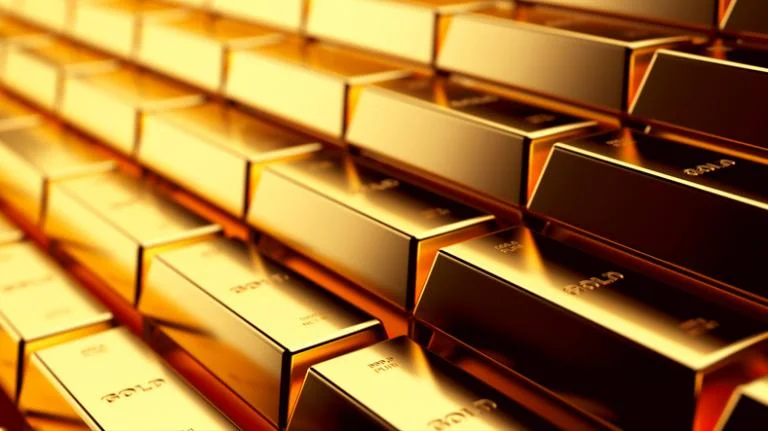It’s easy to get mesmerized by the number. Gold is trading at over $4,000 an ounce. The ticker flashes a gain of more than 50% for 2025, a figure that makes a mockery of traditional equity returns. Since mid-August alone, the `price of gold` has climbed nearly 20%, a near-vertical ascent while the U.S. stock market has floundered. But fixating on the price itself is a classic case of looking at the thermometer and ignoring the patient.
The real story isn’t that gold is becoming intrinsically more valuable. The story is that the benchmark against which it's measured—the U.S. dollar—is in a historic tailspin.
A recent Morgan Stanley report laid out the brutal truth: the dollar plunged about 11% against other major currencies in the first half of 2025. To be more precise, analysts identified it as the single biggest decline in over 50 years. This isn’t a minor correction; it’s a structural re-pricing of the world’s reserve currency. When the unit of account is failing, assets priced in that unit will appear to soar. Gold isn’t flying to the moon. The ground it’s measured from is simply collapsing.
This isn’t a niche theory whispered among gold bugs. It’s the consensus view. Paolo Pasquariello, a finance professor at the University of Michigan, didn’t mince words, calling the surge a "warning sign" and a "leading indicator of troublesome times." Why soaring gold prices could be a warning sign for the economy - ABC News - Breaking News, Latest News and Videos. Even Ray Dalio, a man who manages capital on a scale most of us can’t comprehend, is urging investors to buy gold as a hedge against what he chillingly calls a potential "civil war of sorts" in the U.S. When institutional titans start using that kind of language, the data points of partisan division and political gridlock suddenly feel a lot heavier.
A Crisis of Confidence, Quantified
The flight to gold is, at its core, a flight from a confluence of systemic risks. Each one is a data point feeding into a single, terrifying algorithm of uncertainty. The U.S. government is currently shut down, which means the flow of critical economic data from agencies like the Bureau of Labor Statistics has been severed. How are investors supposed to price risk when the official risk-measurers have gone dark? It's like asking a pilot to land a plane after someone has smashed all the instruments on the flight deck.
This data blackout comes at the worst possible moment. The last jobs report we got, for August 2025, showed a sharp drop-off in hiring. Worse, previous estimates for 2024 and early 2025 were revised down, showing far fewer jobs were created than initially reported (a common but deeply worrying trend during economic inflection points). We have a slowing labor market, gradually rising inflation, and now, no new information to tell us if the trend is accelerating.

Into this vacuum steps the Federal Reserve, which is widely expected to cut interest rates again in October. This would be the second consecutive rate reduction, a clear signal that the central bank sees weakness ahead. For an asset like gold, which pays no dividend, lower interest rates are a direct subsidy. Why hold a savings account yielding next to nothing when you can hold a hard asset that’s appreciating in an environment of currency devaluation? Aakash Doshi at State Street put it simply: the Fed’s "rate-cutting cycle could benefit gold." That’s the understatement of the year.
I've analyzed market reactions to Fed pivots for over a decade, and the velocity of this move into gold is unusual. The market isn't just pricing in a couple of rate cuts; my analysis suggests it's pricing in a fundamental loss of faith in the institution's ability to navigate the storm. The Fed is being forced to choose between supporting a fragile economy with cuts (and devaluing the dollar) or defending the dollar with hikes (and likely triggering a severe recession). What does it say when the market assumes they'll choose the path of managed decline?
The Canary in the Coal Mine Is Now a Vulture
Of course, there are dissenting voices. Jim Wyckoff, a senior analyst at Kitco Metals, correctly notes that gold is in a "boom cycle" but cautions it will likely enter a "bust period sooner than investors expect." This is a perfectly logical take. No asset goes up in a straight line forever. But the core question is: what is the catalyst for this bust?
For the `gold price today` to reverse course, confidence in the U.S. economic and political system would need to be restored. That would require an end to the government shutdown, a series of surprisingly strong economic data releases, a resolution to the partisan warfare in Washington, and a Federal Reserve that can suddenly project strength and stability without cratering the bond market. Does that sound like a plausible scenario in the near term?
The current `gold spot price` is acting as a real-time sentiment indicator, and it’s screaming that the market sees none of that on the horizon. It’s a referendum on the perceived stability of the United States. Investors aren't just buying a metal; they are selling a narrative—the narrative of American exceptionalism and the unimpeachable safety of its currency and debt.
This is more than a simple safe-haven trade. In previous crises, investors bought U.S. bonds. This time, they’re fleeing both the dollar and long-term U.S. debt, a sign of stress that is far more alarming. Gold is the default option when all other defaults seem possible. The question is no longer whether gold is a good investment. The real question is, what does it mean for the country when it’s seen as the only safe investment?
A Failure of Confidence, Priced in Dollars
Ultimately, the number—$4,000—is a distraction. It’s a vanity metric. My read of the data is that gold isn't the asset; it’s the measuring stick. What we’re witnessing is the market attempting to find a stable point of reference in a system that has lost its anchor. The current `gold ounce price` isn't a signal of the metal's strength; it's an invoice for decades of fiscal profligacy, political decay, and the slow-motion erosion of institutional trust. And right now, that invoice is coming due.
